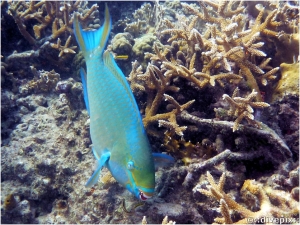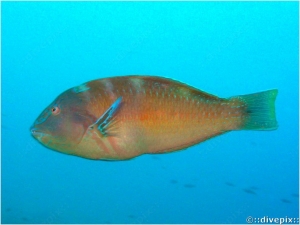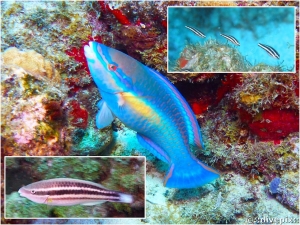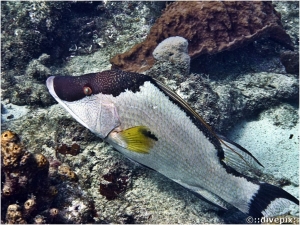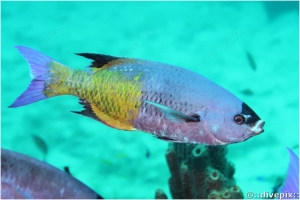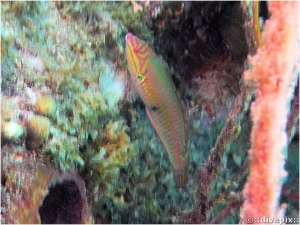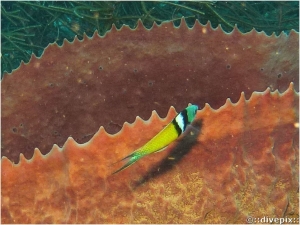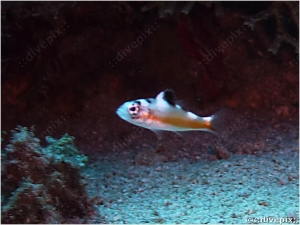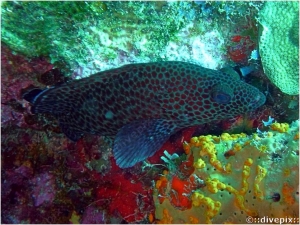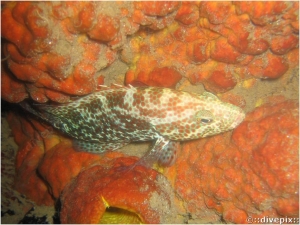




Eric H. Biass
Queen Parrotfish
| Aspect: | All parrotfishes sport a strong elongated oval body boasting large scales, prominent mouth with bill-like frontal teeth (hence the name) with which they bite away at coral. |
| Population: | Common. |
| Notable feature: |
Initial (or intermediate) phase: Overal dark grey body with white longitudinal patch from pectoral fin aft, maroon tail fin. Terminal (adult): generally dull green-grey body with characteristic green or blue bars above mouth plus another larger one under the mouth often interrupted by a pink bar. Horizontal green patch also adorns upper part of the eyes. |
| Environment: | Swims around rocks and coral boulders from which it violently bites off coral and algae. Builds a protective film bubble when sleeping at night under rock recesses, as seen in one of the photos below. |
| Behaviour: | Can be approached to about one metre. |
Puddingwife
| Aspect: | Generally orange-pink body with green-blue lines on forehead and "chin", but depending on age can adopt greener or bluer tones. |
| Population: | Common without being ubiquitous. |
| Notable feature: | Five white patches on upper body, blue-green fins, tail included. |
| Environment: | Swims over coral sand bottom, in relatively shallow waters. |
| Behaviour: | In constant movement, difficult to approach. |
Princess Parrotfish
| Aspect: | All parrotfishes sport a stong elongated oval body boasting large scales, prominent mouth with bill-like frontal teeth (hence the name) with which they bite away at coral. |
| Population: | Quite common. |
| Notable feature: |
Juveniles: hardly one inch-long, white with three black horizontal lines, transparent (almost invisible) fins. Initial (or intermediate) female phase: afore-mentioned black bars turn brown and fade, while fins turn opaque. Advanced Initial phase: body and fins gradually turn yellow while the lower longitunial brown line fades away (see sample amongst pictures below). Terminal male phase: generally blue-green body with characteristic bright yellow patch aft pectoral fin fading backwards, mauve to amber-edged dorsal fin and tail fin, green-bordered purple-blue line straddles upper snout and runs sidewards across the eyes to fade towards the gill area. |
| Environment: | Swims around rocks and coral boulders from which it violently (as seen on one of the photos below) bites off algae. Builds a protective film bubble when sleeping at night under rock recesses. |
| Behaviour: | Can be approached to about one or two metres. |
Hogfish
| Aspect: | Narrow, but tall body with very prominent "forehead", tail base and tail fin. Dramatic appearance changes from juvenile to intermediate and terminal phases: first orange with white random blotches, turning plain darker orange (when distinctive darker "forehead" appears), and then white with dark patch on head and finally plain grey with black forhead, dorsal fin and vertical bar across tail base, odd bright yellow pectoral fins with black longitudinal stain aft these. |
| Population: | Quite common. |
| Notable feature: | Systematically deploys the first three long spines of its dorsal fin vertically whenever it stops swimming (or while sleeping at night), parking them down as soon as it moves forwards again (almost comical to watch). Can be affected by ciguaterra. |
| Environment: | Usually wanders about close to bottom in quiet waters, finds food in coral sand bottom (zooplancton, small crustaceans etc) thanks to its prominent snout, which owes it its name. |
| Behaviour: | Unafraid, can easily be approached (quietly of course). |
Creole Wrasse
| Aspect: |
Always feature a black snout over white or light grey lips, whether in juvenile or adult (terminal) phase. Adult: generally blue to purple head and upper body over red belly and yellow rear body. Blue tail fin. Juvenile: blue with purple-ish tail fin. |
| Population: | Common. |
| Notable feature: | Blue to purple tail, even when sporting brightest rear body. Juveniles always part of schools, older specimens can be solitary. |
| Environment: | Open waters, along coral cliffs. |
| Behaviour: | In constant movement, difficult to approach. |
Clown Wrasse
| Aspect: | Generally green body with pink reflections, but head in yellow base tones with marked pink/salmon cross lines above mouth, longitudinal below mouth. |
| Population: | A rare encounter around Ilets Pigeon. |
| Notable feature: | Pink/salmon dorsal fin. |
| Environment: | Around rocks and coral boulers |
| Behaviour: | In constant movement, difficult to approach. |
Bluehead Wrasse
| Aspect: | As typically seen: long elongated body with sparrow tail. Blue head (as name implies), followed by thick black vertical bar aft the gills and across the perctoral fins, large white v-shaped section followed by one vertical black bar and yellow body down to greenish sparrow-like tail (though yellow body can readily be green) |
| Population: | Common |
| Notable feature: |
Above description refers to terminal male phase. Juvenile phase: yellow body with thick horizontal black line running from snout, across eyes, to tail. Comparatively large black stain on dorsal fin. Intermediate: gradually loses transverse black line and dorsal fin black spot, while acquiring white belly. |
| Environment: | Swims around rocks and coral boulders, but are carnivorous. |
| Behaviour: | In constant movement. |
Tobaccofish
| Aspect: | Small white body crossed by longitudinal fading orange line, black blotches in upper half of body. |
| Population: | Not common. |
| Notable feature: | Short, tall dorsal fin |
| Environment: | Close to coral sand bottom, in quiet waters, close to rocks and coral boulder recesses. |
| Behaviour: | Difficult to spot. |
Rock Hind
| Aspect: | Typical sea bass outline, but features prominent, almost toad-like eyes. Base colour studded with dark red dots dramatically changes from dark gray/green to almost white. |
| Population: | Common. |
| Notable feature: | Dark spot straddles upper tail root |
| Environment: | Close to bottom in quiet waters, around rocks and coral boulder recesses. |
| Behaviour: | Shy. |
Red Hind
| Aspect: | Features typical sea bass outline, usually cream and pale green base with red dots. |
| Population: | Rarest of groupers seen here. |
| Notable feature: | Larger than similar Graysby, but does not carry the latter's dots on dorsal fin base. |
| Environment: | Close to bottom in quiet mid-depth (25 metres) waters and rock fractures. |
| Behaviour: | Shy. |



